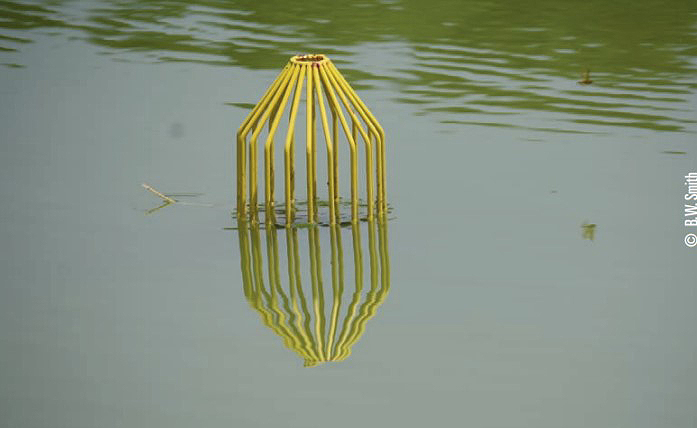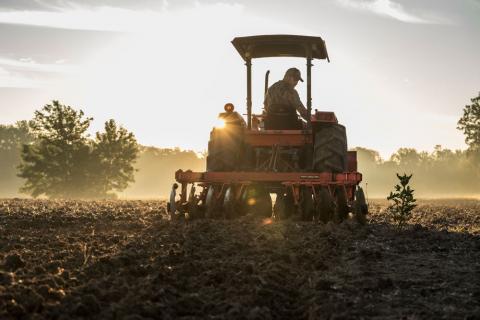Barry W. Smith | Originally published in GameKeepers: Farming for Wildlife Magazine. To subscribe, click here.

pond into the bass lake. This size pipe comfortably carries
water and fish without any undue stress on the forage fish.
What is a nursery pond? In the sense of this article, it is: a pond in the immediate watershed of your existing bass lake that can be used to grow proper-size forage fish to enhance the growth of your bass. Nursery ponds are designed to drain completely through a six-inch drainpipe directly into your lake. The idea is to have a pond free of wild fish and/or predators (bass) and grow a crop of bait fish that could be added to your bass lake simply by draining the nursery pond after the crop has attained a desirable size. The bass in your lake would then have an extra supply of food to increase their growth.
Most recreational bass lakes contain a variety of bass sizes from recently spawned fingerlings to a separate age class of bass for each year there has been mature bass in the lake. Because there are so many sizes of bass to feed each year, it is often difficult to maintain enough larger forage or food to keep the adult bass fat and happy. Having a nursery pond that is contiguous to the bass lake is a method that will produce extra forage for your bass and increase their size.
Nursery Ponds are Terrain Dependent

designed so that all the water and fish may
drain into the pipe. A simple plastic gate
valve is installed to allow the pond to be
drained or sealed for the refilling of the pond
and production of another crop of forage.
Unfortunately, the terrain surrounding most bass lakes does not lend itself to the construction of a nursery pond. There needs to be a natural depression or valley in the immediate watershed that is of higher elevation than the existing lake. This site should be large enough to construct a pond that can provide a significant amount of bait fish to the existing lake. Typically, ponds less than a quarter of an acre cannot contribute enough forage to be worth the expense of constructing the pond and the effort and cost to raise bait fish.
Many lake owners consider pond sites that are outside the watershed of their bass lake to produce extra forage. “We can raise the forage and move them to the lake.” In casual conversation over a couple of adult beverages, this idea may sound good. However, from a practical standpoint, it is a very bad idea. Harvesting and transporting forage requires special equipment and expertise, so you should not try this at home!
The key to success of a nursery pond is that the fish are not handled during harvest or transport; simply open the valve and they are transported in water directly into your bass lake.
Production
Nursery ponds, if properly managed, can produce from 500 to 1,000 pounds of bait or forage fish per acre. This can result in a significant amount of additional food for your bass, if the ratio of the nursery pond to the bass lake is sufficient. We usually recommend a half-acre nursery pond for a lake that is no larger than 15 acres.
There are several species of forage or bait fish that have worked well in nursery ponds; they include bluegill, threadfin shad, golden shiners and tilapia. Please check with your local Department of Wildlife and Fisheries to insure that tilapia are legal in your area. All of these species feed off natural productivity of your nursery pond. This can be enhanced by a good fertilization program. Applying five pounds per acre of Perfect Pond Plus fish pond fertilizer to maintain a plankton bloom of 18 to 24 inches can triple your bait fish production. All of the above species will also feed on small floating catfish pellets. An automatic fish feeder, set to feed two to four times daily can be used to further increase the bait production. Your success in raising bait fish for your bass depends directly on your management input. If you stock your nursery pond and forget it until the fall, your production will be poor.
Designing Nursery Ponds
These bait fish production ponds do not need to be deeper than five feet. The upper ends should not be shallower than two and a half feet and should taper to the central drain pipe so that all of the water and fish can drain out when the valve is opened. The drain pipe, which should be at least six inches in diameter, should extend over or into the lake below. The valve can be a simple plastic gate valve with a turtle excluder on the front side of the valve. This excluder will prevent turtles and large debris from partially blocking the drain pipe and leaving most of the fish floundering in the mud of the pond bottom during draining. Like any other pond or lake, the bottom of the pond should be limed with four tons per acre of agricultural limestone to maximize fish production.

Stocking Nursery Ponds
Ideally, the ponds should be over half full in the early spring when the brood bait fish are stocked. As the pond fills from late winter and spring rain, rising water will stimulate spawning. In the southern U.S., stocking rates depend on the species but are generally as follows: golden shiners approximately four inches long are stocked in early March at 1,000 to 2,000 per acre (approximately 10 to 20 pounds of four-inch-long fish). Threadfin shad can be stocked in early March at a rate of 200 to 500 three-inch to four-inch-long shad per acre. Bluegill can be stocked in March at the rate of 200 four-inch-long to five-inch-long bluegill per acre. Tilapia adults that are six inches or larger, can be stocked during mid-April at a rate of 25 pounds per acre, where legal. Tilapia do not like cool water and should not be stocked too early in the spring or they may develop a fungal or bacterial infection and some consequent mortality.
Draining Nursery Ponds
There are two general philosophies regarding draining nursery ponds. The most common is to let the bait fish spawn and grow in the pond until early fall, late September or October, and then completely drain the pond into your bass lake. This technique typically produces a range of bait fish sizes that are available to most of the bass in your lake. Let the nursery pond dry during the fall and close the valve in time to catch the winter rain.
The second approach is to drain the nursery pond to within a foot of the bottom during late June or early July and then refill utilizing a lift pump from your lake or a well near the pond. The brood fish that remain in the lake will spawn again during the summer and produce another crop that can be drained into your lake during the fall. This technique works best with tilapia and bluegill. It can increase your total production by growing two crops. You may not be fortunate to have the needed terrain features that would allow the construction of a nursery pond for your bass lake. If you do, consider constructing a nursery pond to produce more food for your bass. You can’t have too much food and you will be surprised at how the extra food will boost the bass growth!




























